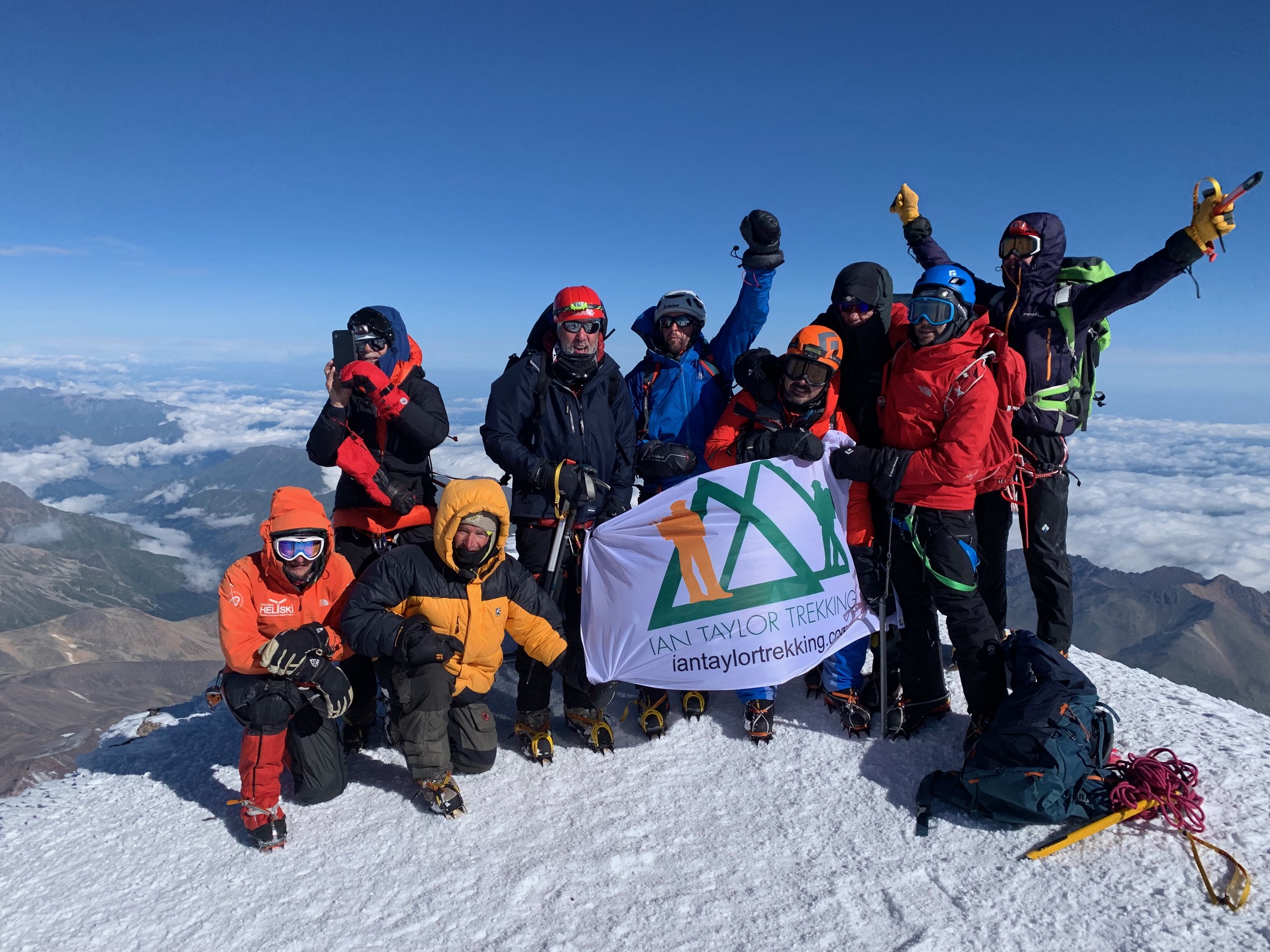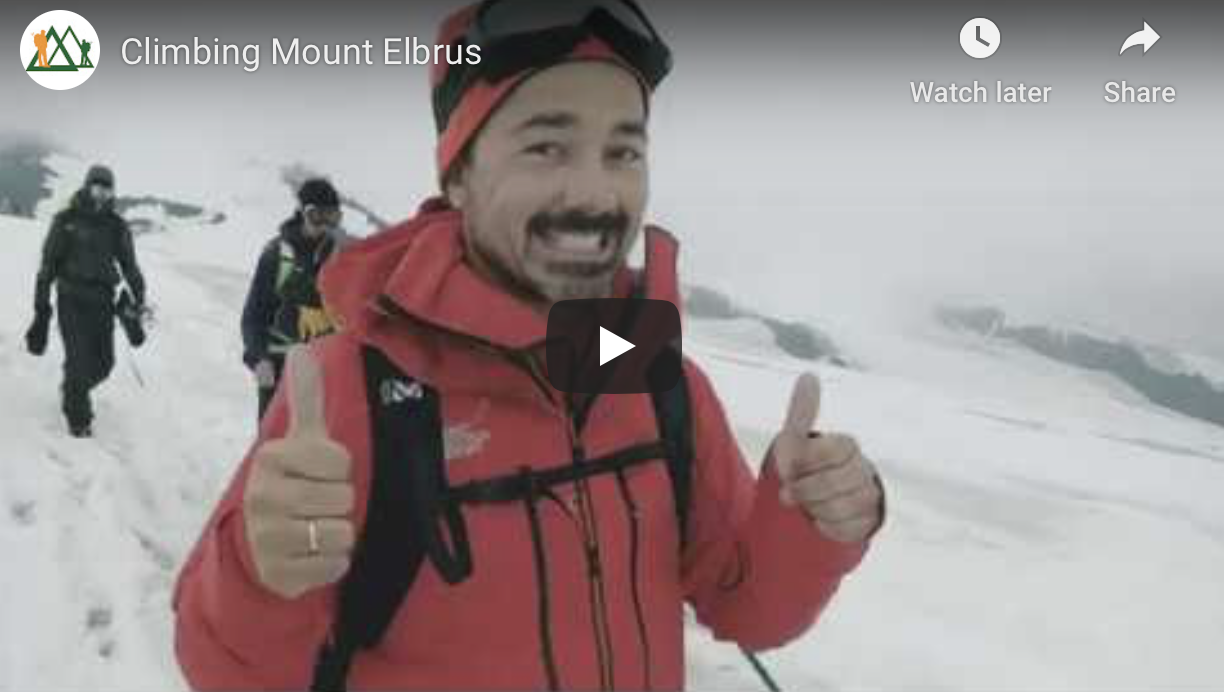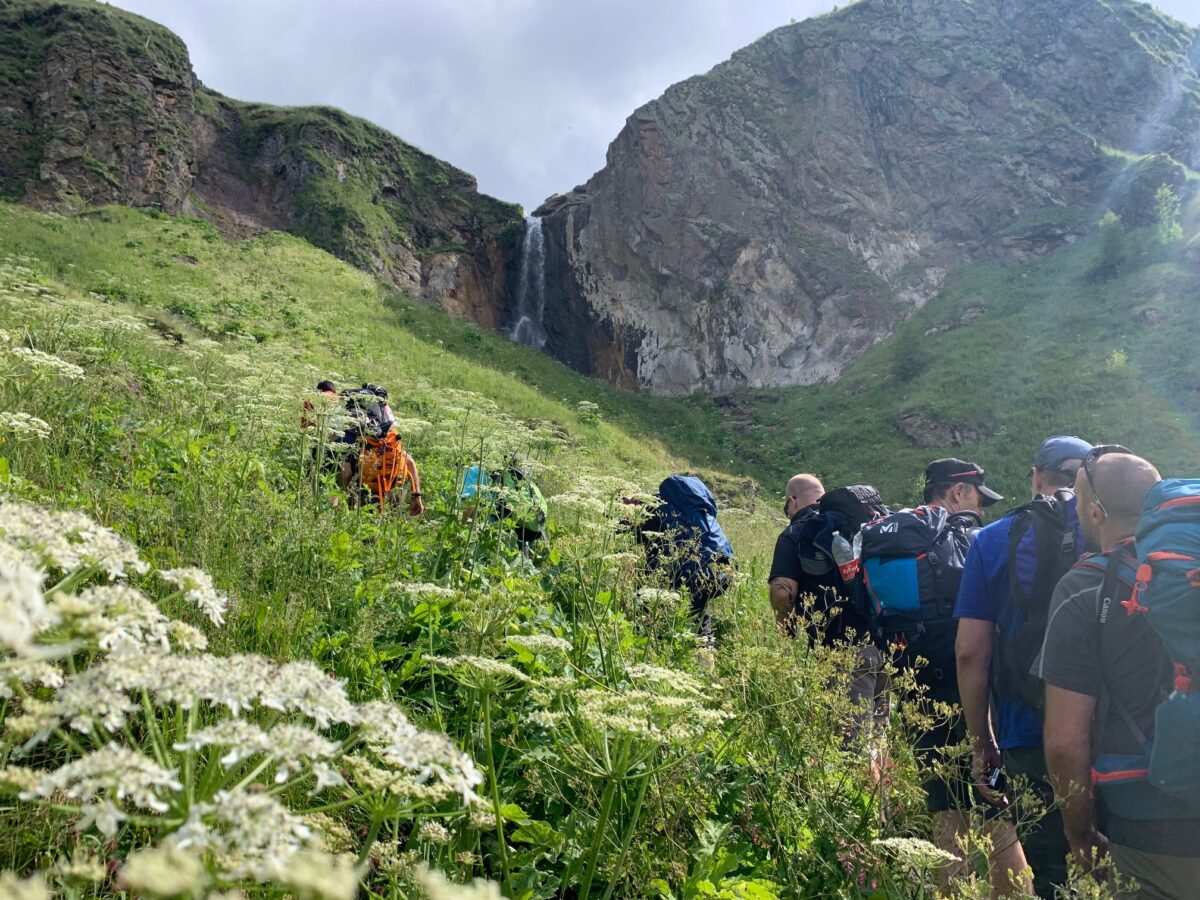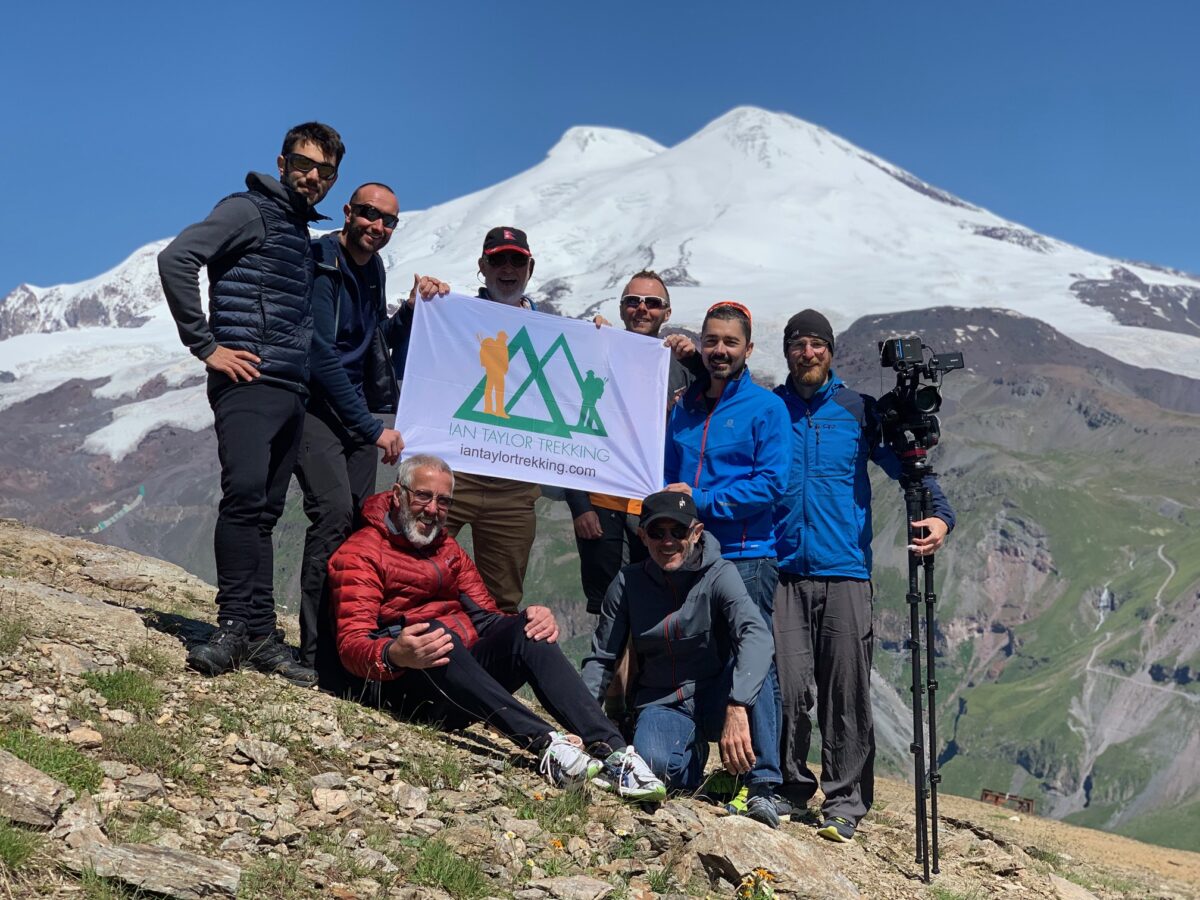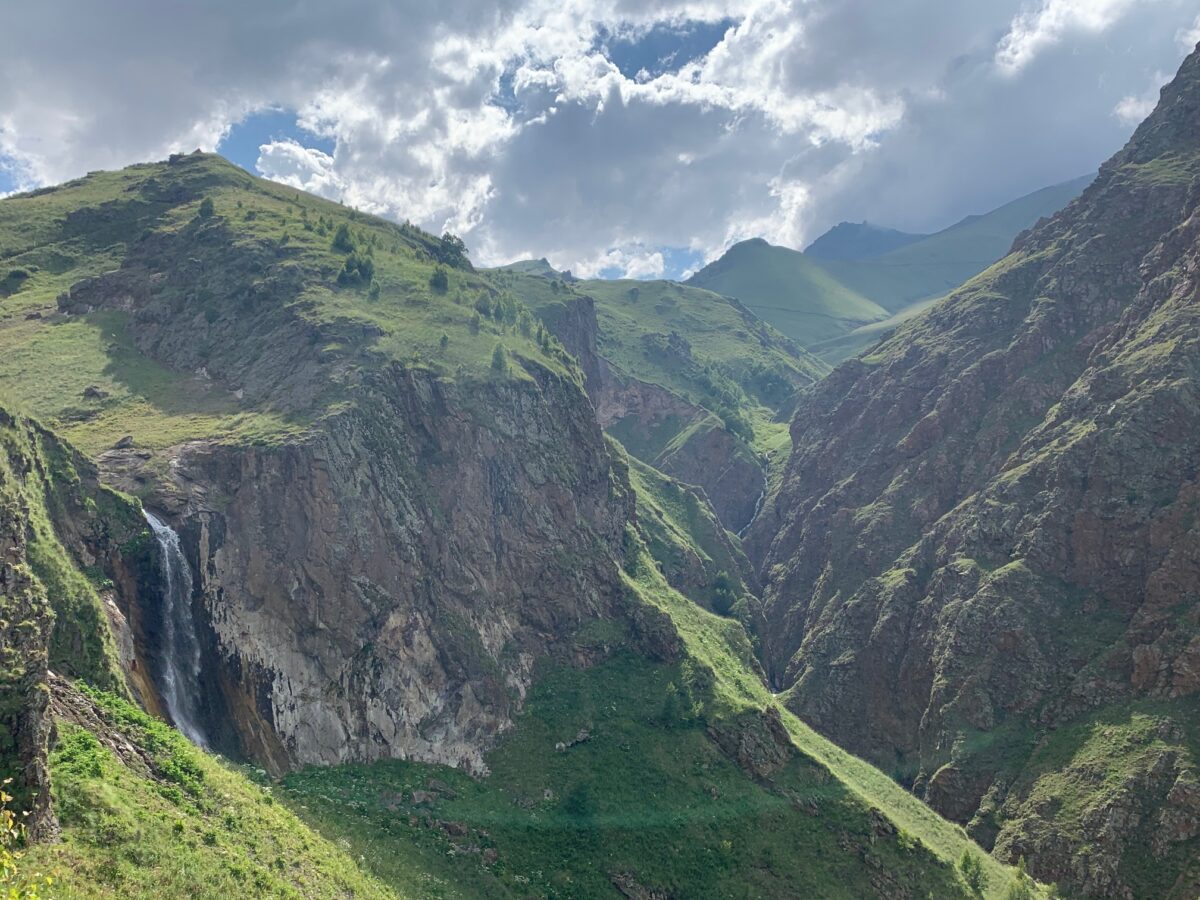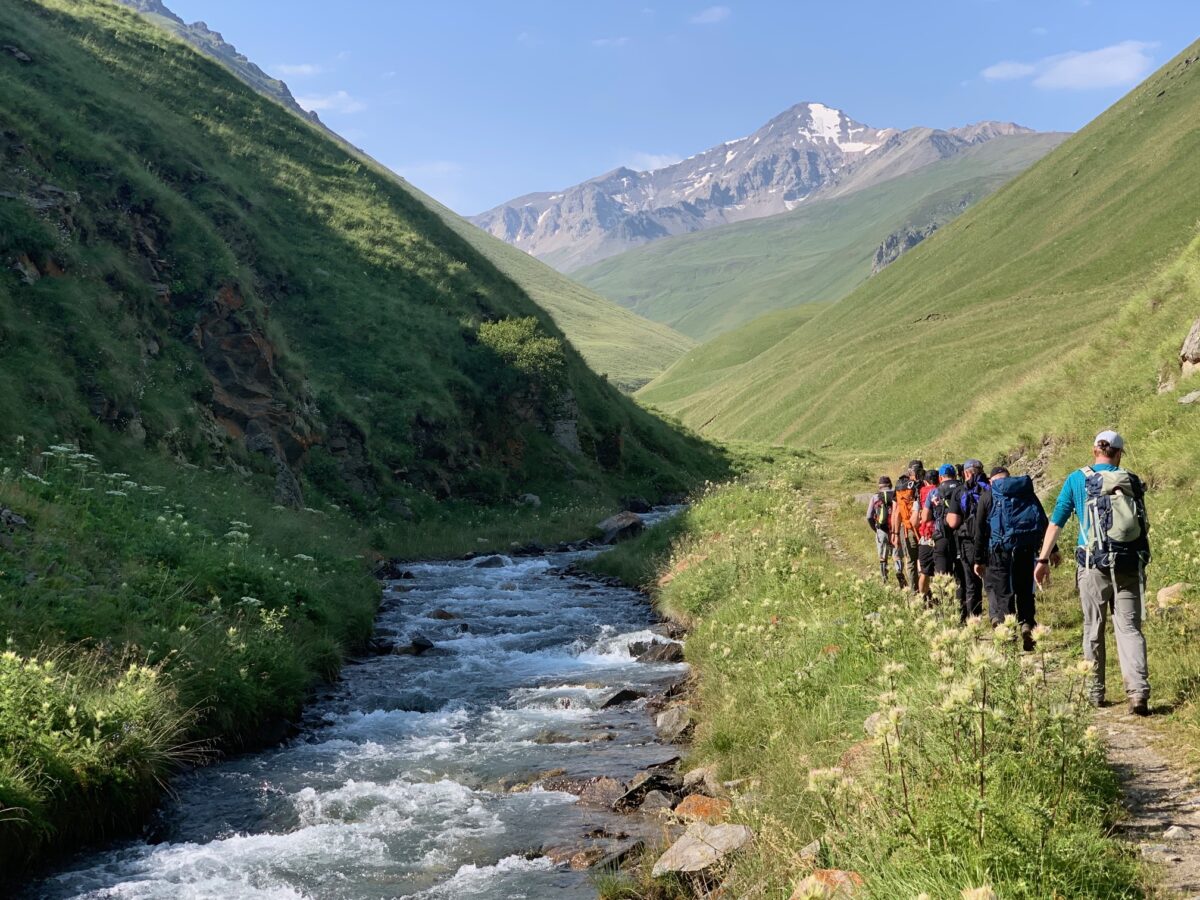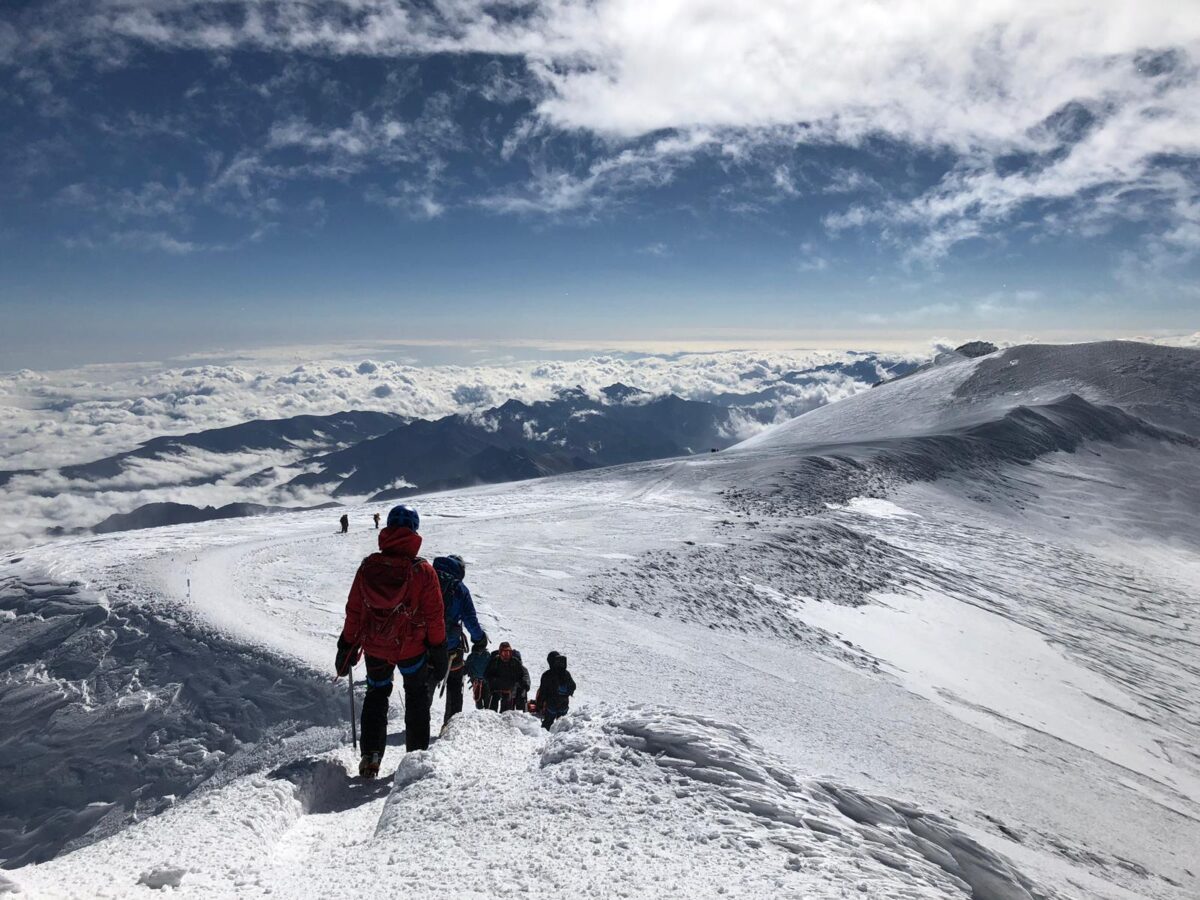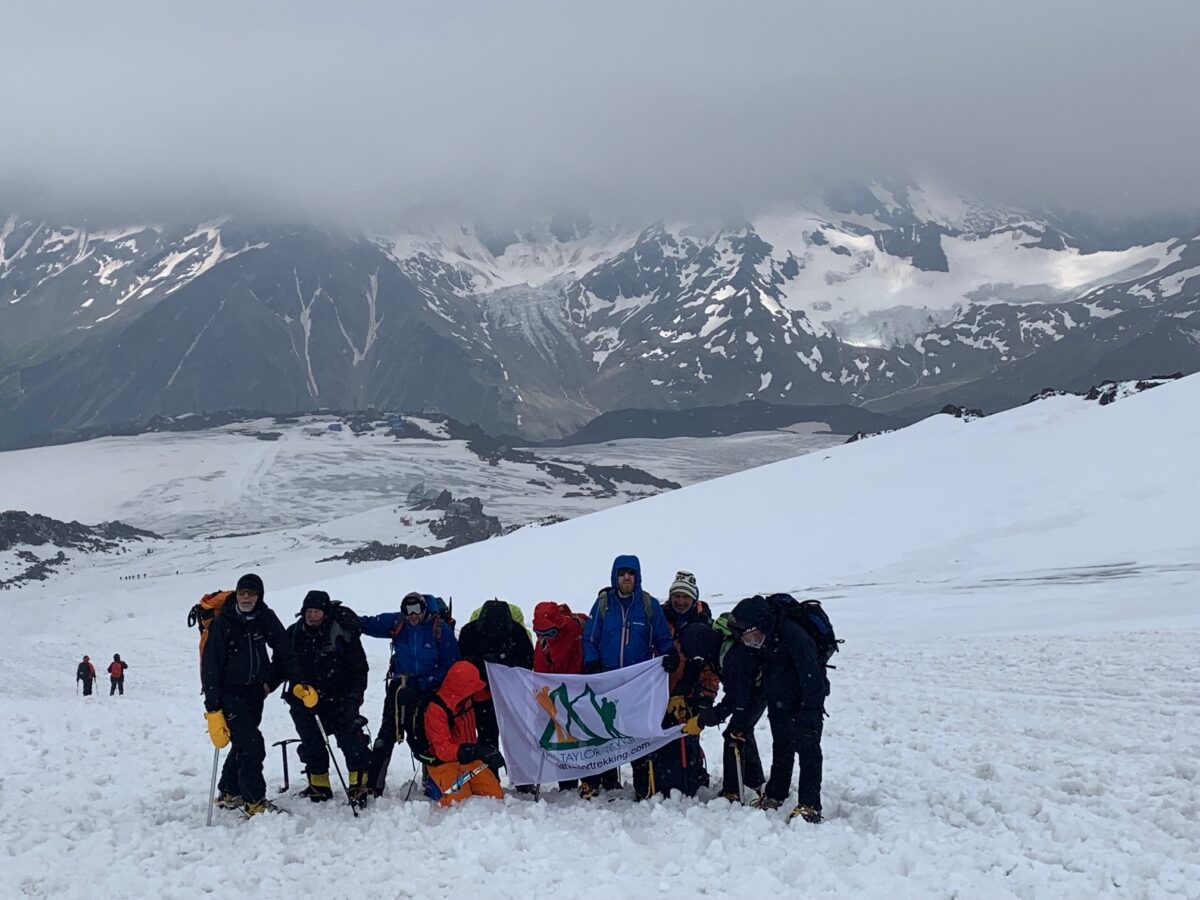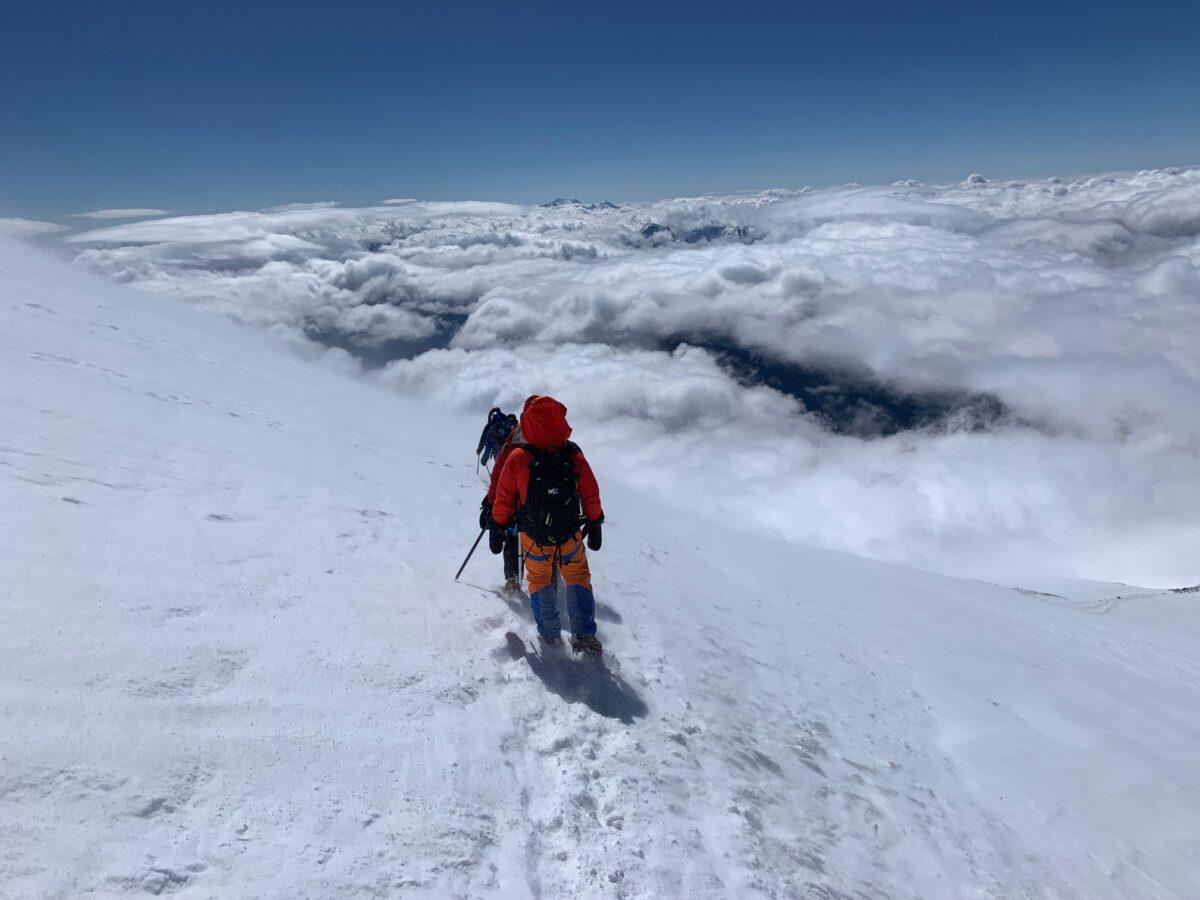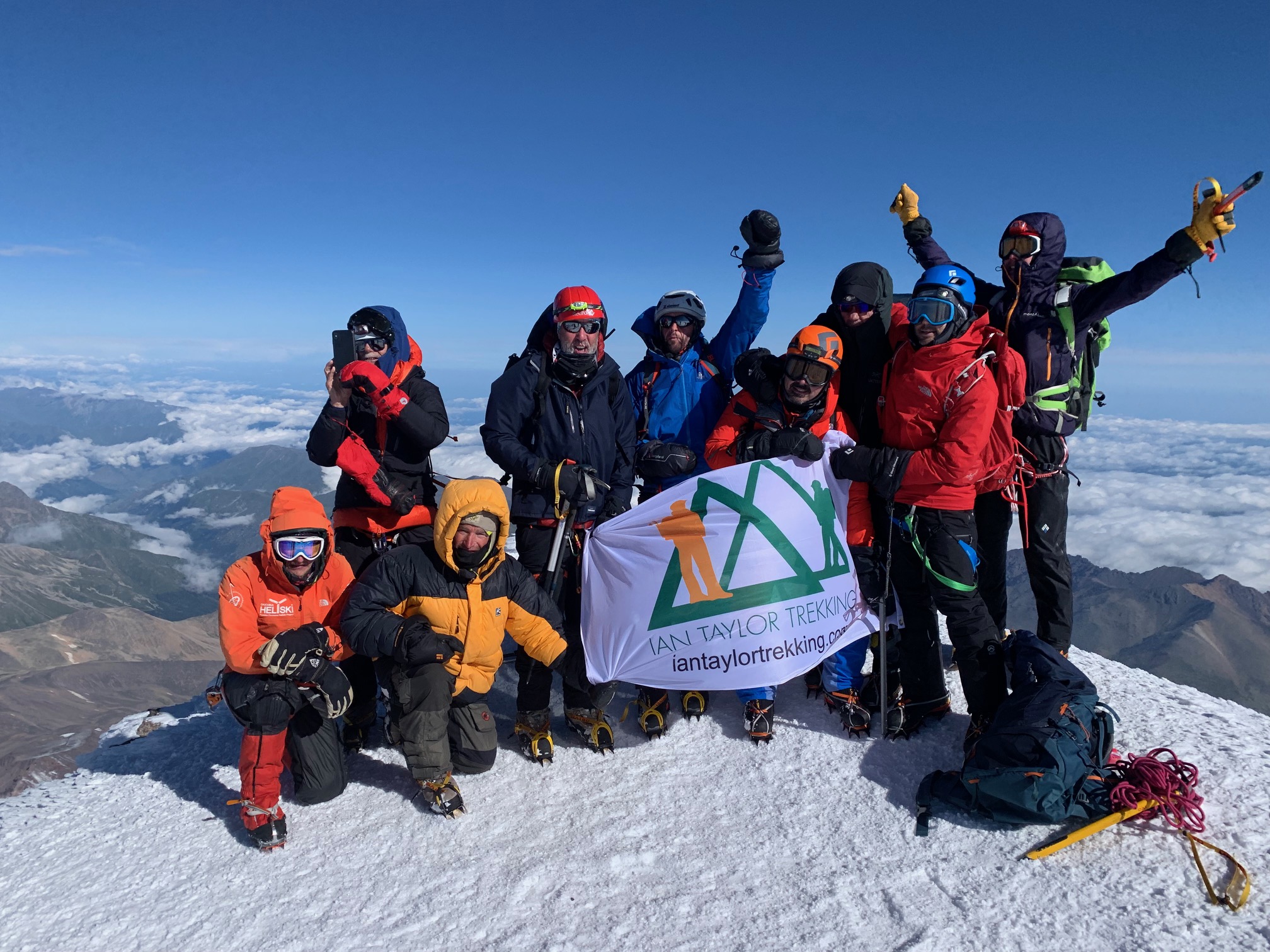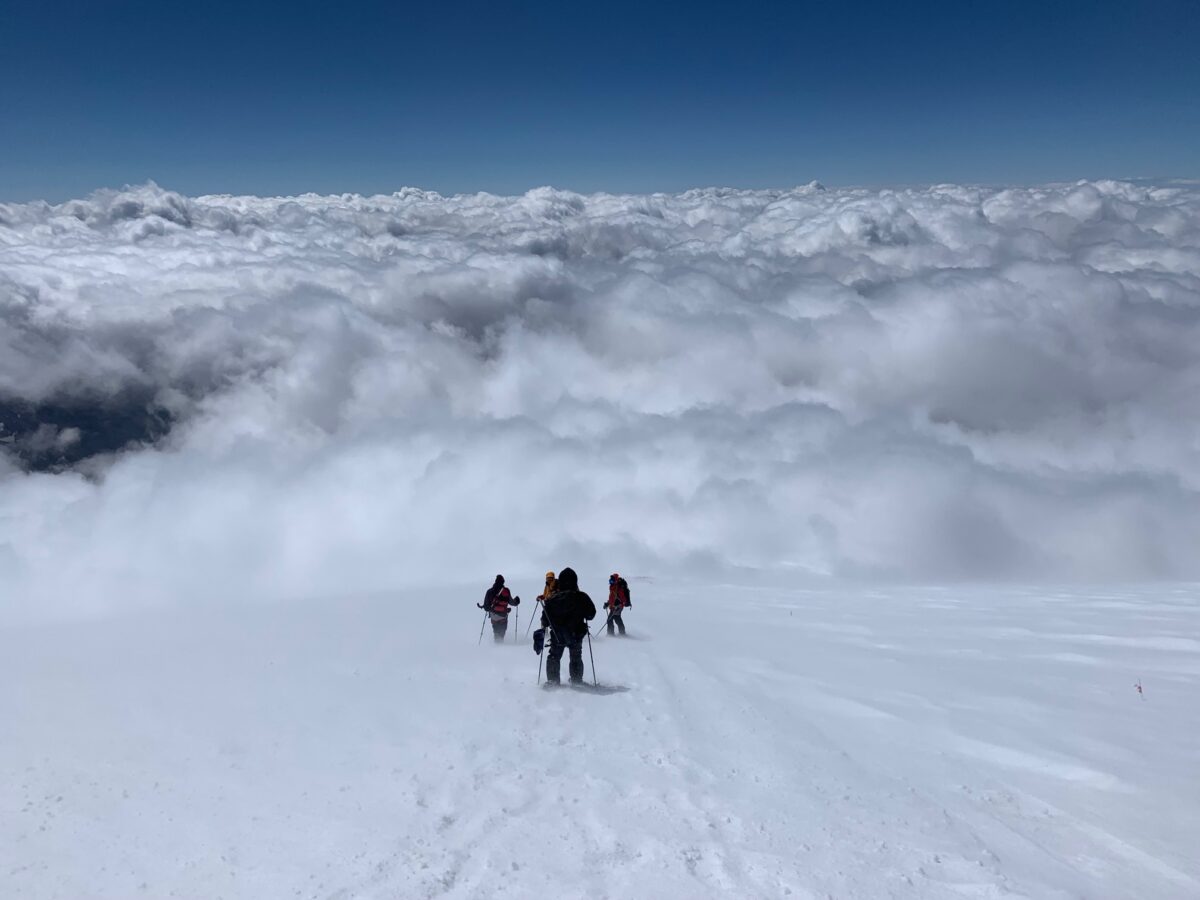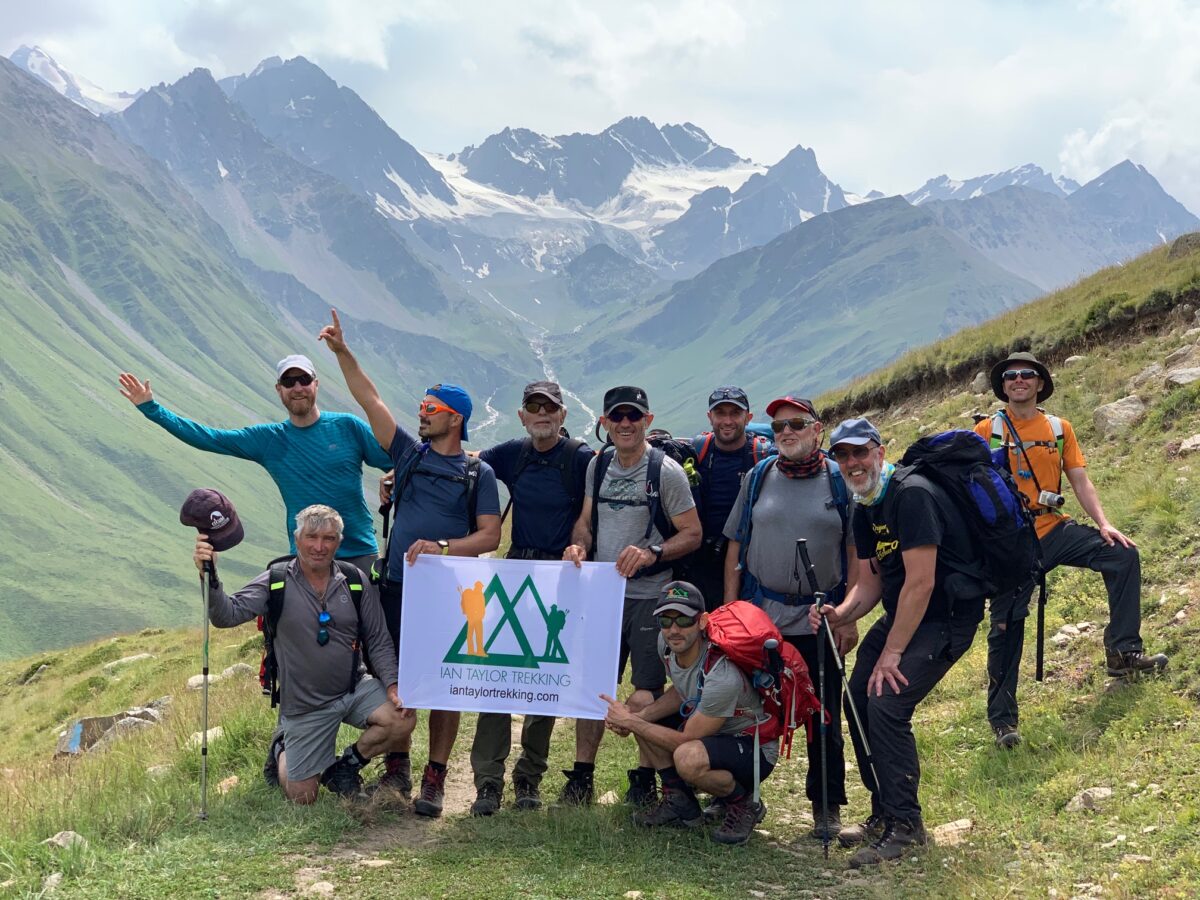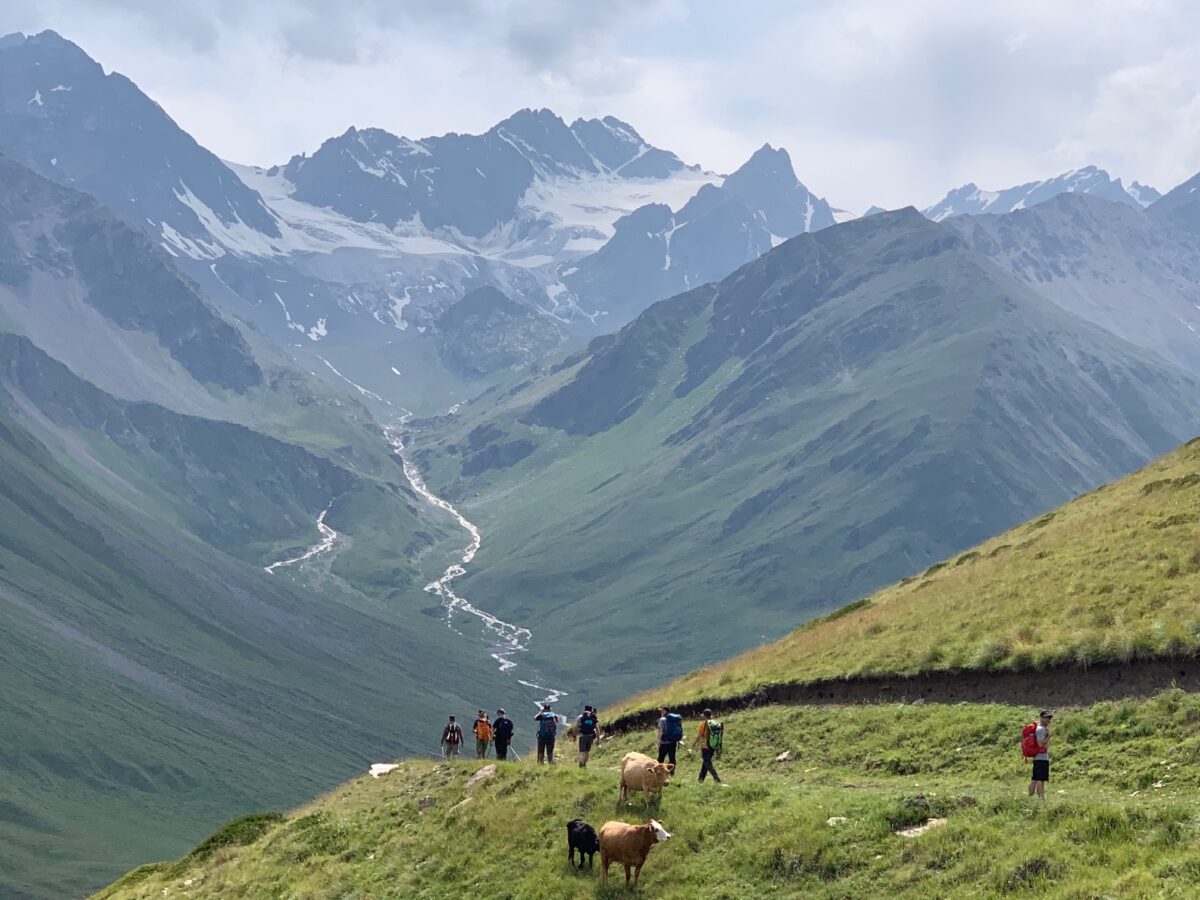Mount Elbrus
We want you to be successful so we really only run twelve day climbing programs with proper acclimatization which is the key to success on high altitude mountains. The price of our 12 day trips start from $3,300. Our 7 day itinerary start from $2,400.
Tips & Advice
Ian Taylor Trekking started running trips to Mount Elbrus in 2006. Over the years we have developed our own unique itinerary for safety and success. We know that more acclimatization leads to better success rates. We also know specific physical preparation leads to a safer and more enjoyable experience.
1). Our Unique Itinerary
We have learned after years of experience that people need more time to acclimatize to the lower levels of oxygen, in order to have a safe and successful trip. Therefore, our favored itinerary is our unique 12-day itinerary. This will help to give your body the time it needs to acclimatize correctly. We start hiking on the northern slopes of Mount Elbrus with our Base Camp at 2,550m/ 8,366 feet. From there we follow a daily routine on hiking higher and sleeping lower. Your team will continue this process for 6 days.
After the acclimatization process, our new base will be at 3,900m/ 12,795 feet. Our mountaineering training starts as we acclimatize further up to 4,800m/ 15,748 feet over a couple of days. In this itinerary we include three nights in which we can make summit attempts. Most companies are not doing this, and we have seen over the years that it is a main factor in why more people on our trips are making it to the summit. Learn more.
2). Expert Training Advice
We offer personal service with training advice for our clients, 5 days a week. A lot of people underestimate the physical preparation needed for Mount Elbrus. If you decide to climb on the northern side there is minimal safety in place, no helicopters and no snow cats. Therefore, we use the southern side of Mount Elbrus for our final ascent. This offers you better safety and success.
We want to make sure that you have the best information on how to complete this adventure safely and successfully. There are some long 8+ hour days, with over 1,000m/ 3,280 feet of up and down hills on steep terrain while on the trail and mountain. We have professional training advice available to you 5 days a week. All you have to do is e-mail us and we can schedule a call. Read more.
3). Climb with an Everest Summiteer
Why not sign up to one of the trips that Ian personally leads? You can walk through the region with someone who not only has reached the top of Mount Everest! and climbed Mount Elbrus over 10 times. Ian usually leads one Elbrus trip per year with 14 spaces open. You will need to book far enough in advance for these trips. Sign up and get access today. Read more.
4). 25 Years Experience
We have years of experience managing teams on the ground in the Caucasus Mountains. Our head guide has been at the forefront exploring these mountains for over 25 years. He is well connected on the ground with access to all the key organization and authorities. All our other guides are highly qualified in a range of mountaineering disciplines. We always have 1 guide for every 4 clients high on the mountain along with 1 guide for every 6 clients on the trekking portion of our trips.
5). Fully Trained Staff
All of our guides hold professional mountaineering qualifications and wilderness First Aid Certificates. They are able to get you the help you need in case of an emergency. Also, our guides will carry satellite and local phones with them. We want to make sure all of our teams have the best chance at safely reaching their goal. With more guides with your team, they will be able to more efficiently manage your safety on the mountain and also give you a better experience along the way.
6). Quality Gear
Our Elbrus trips use Red Fox tents. They are a more spacious tent for the nights camping on the northern and eastern side of Mount Elbrus. We do have the option for a single tent for an additional fee, however all accommodation are on a shared basis. The huts at 3,900m on the southern side of Elbrus have 4 people per room.
7). All Inclusive Packages
All of our trips include three, two course meals each day on the trail. Therefore, you do not have to worry about bringing extra funds for your food. After we pick you up at the airport, the team will have lunch and then drive to the northern side of Mount Elbrus. We can guarantee quality food throughout the trek because we fury fresh food into our campsites on the camping portion of our trips.
We have vehicles to carry all our duffle bags, tents, equipment and you will only have to carry your backpack each day on the trail. When we go higher we take all our gear up the gondola to our huts at 3,900m/ 12,795 feet. When we are based in the huts we include 3 meals a day. We will have set times for meals each day and have 45 minutes per meal in the huts. Making sure you get enough food on the trail is very important. Therefore, we provide all your meals as part of your trip.
9). Small Group Sizes
We only work with small group sizes. The maximum number of people per team will be 12 people. Some of our groups are even less people with only 6 or 8 team members. This will therefore give you are more personalized experience on Mount Elbrus. You can move as a team and experience more of this reason together.
We believe the journey is far more valuable than the destination. Building a team throughout the 12 day program so you can acclimatize well and experience the best of Mount Elbrus. Our guides will monitor your heart rate and oxygen saturation morning and night to make sure you are acclimatizing correctly to the lack of oxygen.
10). Deal with the Experts
Climbing Mount Elbrus is no easy task and you need the team, support and experience with you and behind you on the mountain. Contact us for more information on our unique itinerary that we have tried and tested over many years. Read some REVIEWS and book early to secure your space on this trip of a lifetime!
1). Having the Right Itinerary Will Make all the Difference
We have developed the best 12 day itinerary possible for you to be safe and success, along with getting the most out of your adventure into the Caucasus mountain region. More acclimatization gives you a safer and more enjoyable experience going to high altitude. We can run 8 and 9 day itineraries for small groups.
2). The Right Physical Training and Preparation
Climbing Mount Elbrus is harder than climbing Kilimanjaro, so it Is essential you come physically prepared. You will be moving up and down steep, trails, snow and ice fields at very high altitude. Each summit attempt can be very different, so if you are thinking of climbing Mount Elbrus you should aim to be over prepared in case the conditions deteriorate you need to be able to get yourself out of trouble and not be struggling in potentially very dangerous situations. There will be no porters to carry your back pack. LEARN MORE.
3). Make Sure you Have the Right Clothing and Gear
I am a big fan of quality lightweight gear. If you climb in the warmer months of July and August you will need a wide range of clothing as if you can experience temperatures of 20 degrees Celsius in the trekking phase and down to as low as -20 Celsius in the mountaineering phase of the trip. You need proper trekking boots, waterproof gear and range of merino wool layers. If you are climbing Elbrus in June or September you experience even lower temperatures and will absolutely need to make sure you have quality layer, correct down jacket. The correct mountaineering boots are essential to keep your feet warm and you need excellent gloves, layers and safety equipment.
4). Make Sure you Climb from the South Side
Don’t buy into the nonsense that you need to climb on the North side of Mount Elbrus. If you are part of a mountaineering club, you have been on numerous high-altitude trekking and mountaineering adventures. Then maybe the north side of Elbrus is for you and we can help you. If you are not used to load carrying of serious weighted backpack and able for climbing on steep terrain from 3,900m/ 12,795 feet up to 5,642m/ 18,510 feet. Then you should not be climbing on the North side of Mount Elbrus.
We love the north side of Mount Elbrus, but if you want to be safe and successful and you are not that experienced, but fit and strong then the South side has better safety in place for you. There are lots of inexperienced people falling into crevasses on the north side, teams moving without ropes. The Southern route up Elbrus has snow cats, snow mobiles, easier route along with better facilities, huts and services. Check out our itinerary we have the best of both. We spend 3 nights acclimatizing on the northern side of the mountain, then 3 days on the beautiful eastern slopes of Mount Elbrus, before moving around to the southern side of the mountain for more acclimatization and potentially 3 attempts at the summit. Check out our TOP 10 TIPS
5). Patience as you Await the Right Weather Conditions
The weather can be harsh. For those of you who follow us on Instagram you will see our raw footage from the mountain and know that winds can gust over 60 miles an hour. Temperatures can be below -20 Celsius even in the warmest months high on the mountain so having more days for acclimatization is so important. Also having more days for your summit attempt is important. We have 3 potential nights/ days that we can give the summit the best possible shot in a safe and managed way. You need to pick and ITINERARY with more days. Why travel halfway around the world to be unsuccessful because you do not have enough days available to reach the summit. Do not make this mistake.
6). Be Mentally Prepared for Your Mount Elbrus Climb
Do some mental preparation and get to understand the trek and climb from our video’s and pictures. You would gain a lot of mental strength from prior altitude experience and your extensive training regime. Mount Elbrus and any mountain region demands respect. Try getting out and doing some wilderness trekking, walking and get used to your gear and being comfortable going to the toilet outdoors. Sleep in a tents and use the air mattress, sleeping bag and mountaineering equipment you will be using on the Mount Elbrus.
7). Have 1 Guide for Every 4 Clients on the Mount Elbrus
Have the right amount of support staff. We have 3 guides and staff or each team of 12 team members when we go high on the mountain. You also want to be in a smaller team. All our trekking team have a maximum of 12 people per team. We also have a western guide on all our Mount Elbrus trips. Having more staff on the mountain in support of your Elbrus climb, increases safety high on Mount Elbrus. This is important so you get that personal care and attention throughout the whole trip. Make sure you pick a team who have their own highly qualified full time staff on the ground.
8). Hydration, Hydration, Hydration
Pre-hydrate before you start your travels. You should be used to drinking 4 liters per day in the lead up to the trip. You will need to be drinking 4/5 liters of water per day on this trip. When you training you should be drinking a liter of water for every hour of exercise. Coming prepared and ready puts you in much better position to be successful.
9). Bring Multi Vitamins and Nutritional Supplements
Nutritious food is important for any expedition but it can very difficult to eat at altitude and get the right foods. Having nutritional supplements are really important to maintaining a strong immune system and be healthy throughout the whole trip. You will using a high level of exertion daily on this trip and food does not always seem appealing so making sure you have vitamins and protein bars for recovery and well being is important.
For your summit night you should consider glucose sweets, Clif shot blocks and hyper hydration from Skratch Labs. You should also consider having some familiar food favorites on the mountain. This can also be a mental aid on harder days. There is always plenty of food to choose from on our Elbrus trips, but when your tummy is having a hard time with the altitude, those familiar snacks may be all you can get down. So remember, within reason (you definitely do not want to be carrying too much un-necessary weight up the mountain), bring yourself a little treat when for you may need it the most!
10). Avoid Sunburn at all Costs
Stay out of the sun whenever possible. The higher you go up in altitude, the lower the levels of UV Protection you are getting. While trekking around Mount Elbrus the sun can be punishing. When you start climbing on the glacier the sun can be brutal, giving you solar radiation from its powerful rays. You do not want to get fried. Staying out of the sun is not only good for minimizing those pesky wrinkles and avoiding skin cancer, but it can also improve your chance of summiting.
When you get sunburned you become dehydrated. Being dehydrated can cause all sorts of problems on the mountain and eventually limiting your chance of success. The first way to protect yourself if by applying a factor 50 sunblock throughout the day. The second way of protecting yourself is to always wear your goofy looking, yet extremely important, sun hat. Get yourself a light weight, brimmed sunhat to wear on days when the sun is shining and you will save yourself from some of the dreaded headaches you so adamantly want to avoid.
Contact Experts
If you would like further information about our Elbrus itinerary and trips just CONTACT US and we can help you get all the information you need to be successful. We can help you develop a training plan that will work for you.
We have extensive experience leading treks and climbs on Mount Elbrus. After years of experience, we have added all our important links and pages in one location for you to explore and get the information you need. If you are thinking of climbing Mount Elbrus, then we are always happy to schedule a call with you to answer all the questions you have. CONTACT US today and start planning for your trip to Elbrus.
Picking the Correct Itinerary
The most important things to consider when you are preparing for your trek; making sure you have chosen the right itinerary, putting in the correct physical preparation, and have the right team to get you to your goal. Ian has climbed Mount Everest to the summit and led over 10 treks to Annapurna Base Camp over the years. We have the experience in the region to make sure that you have all the best information for the trip. Check out our upcoming trips.
Important Mount Elbrus Pages
1). Pick the best acclimatization itinerary for your Elbrus trip
2). How you should be training to best physically prepare for your trip to Mount Elbrus
3). Get FREE constant advice from our professional team
4). Understand the daily distances you will travel on Mount Elbrus
5). Have the right clothing and gear for your Elbrus trip
6). Pacing each day on the trail is critical to success
7). Why hydration is critical at high altitude and in low oxygen environments
8). Elevation gains on our Elbrus climbs. This will help you formulate a better training plan
9). What sort of food will I get on a Mount Elbrus trip
10). Read our TOP 10 TIPS for a successful Mount Elbrus Climb
11). What are the best months for Climbing Mount Elbrus
12). What vaccinations should you consider for your Elbrus trip
13). What type of trekking boots should you have for the trek around Elbrus
14). What Insurance cover do I need for an Elbrus climb
15). What additional expenses will I incur on the Elbrus trip
16). You need to know how hard is it to climb Mount Elbrus
17). How to be successful climbing Mount Elbrus
18). Training for hiking downhill. Learn more.
Stunning Views on our Elbrus Circuit
The first thing you need to consider is picking the right itinerary to give you the best experience possible. When going to altitude, you need to give your body adequate time to adjust to the lower levels of oxygen. If you don’t allow enough time in your itinerary, it could potentially ruin your experience and trip. We like to hike and acclimatize on the northern and eastern sides of Mount Elbrus before moving onto the glacier. Not only is this a beautiful addition to your itinerary, it also adds extra days, giving you the chance to acclimatize correctly. We don’t want you to just endure your trek, we want you to fully enjoy the wonderful experience that this region has to offer and adding the extra days does just that!
Climbing Mount Elbrus Requires Excellent Preparation
Breathing techniques, low heart rates, excellent hydration and pacing are all critical factors for you to have a safe and successful experience. You also need excellent physical conditioning to be able to walk up and down stairs and hills with a weighted backpack at high altitude. If you decide to join one of our trips, then we can help you understand what training and preparation that is required for the journey. CONTACT US today and let us help you plan your trip to experience the best of Mount Elbrus.
Preparation & Training
So, you have climbed Kilimanjaro, completed a winter skills course in Scotland or in your home country and maybe done some minor treks at high altitude. You can looking to take that first step into mountaineering and you think Mount Elbrus is the way to go. Ticking off another one of the coveted seven summit is possible. You just need to understand the challenge and come properly prepared. Please do not show up on one of our trips without the right physical preparation.
Our Unique Itinerary
We have the best itinerary out there to help you be successful. We also have the right team, advice and experience to lead you to the roof of Europe. Make no mistake, people die on Mount Elbrus each year. A lack of training, preparation and understanding of what if takes to mountaineer at high altitude in harsh conditions.
Remember, our itinerary and information has been developed and adjusted from 20 years of experience. By leading trips around the world and observing people in the mountains, we know what it takes. We have lead over 50 trips to Mount Elbrus.
Thinking About the Trip
In the trekking portion of the trip, you are going to be walking up and down uneven, steep terrain for hours. You will have a backpack on, maybe carrying 7kg/16lbs. This means you really need to be comfortable doing this exact activity. If you were running a marathon then you would be out running. You are going to be walking up and down hills with a back pack for multiple days then you need to be used to walk back to back days building up your strength and endurance. If you do not understand this CONTACT US.
Load Carry Weight in Your Backpack
My highest recommendation is to work on your load carrying. Carrying weight in the back pack you should be your core training. Spend time building your strength and endurance, while building a strong core and upper body. Most importantly you need super strong legs with endurance. We can help you develop a program.
Even though I go on 10+ trips and expeditions per year. I still need to be training 5 days a week to maintain this specific conditioning. Yes I can go out running, kayaking, surfing but I need to be building up the weight that I carry in my backpack up to 15kg in each session I undertake.
Training in the Gym
If you do not have access to hills, mountains and altitude which most people do not do. You need to be hitting the gym 5 days a week. In my opinion the stair master (rotating stairs) is the best way to gain strength, endurance and cardio all at the same time.
I have always had access to hills and mountains, but I still have to supplement my hill work with 4 days a week in the gym. I use the stair master for most of my training but sometimes like to mix it up and use the treadmill on the highest incline for 45 minutes and then the stair master for another 45 minutes. You also need to stretch, hydrate and build strength with additional weight work. Working out in your endurance heart rate zone is so important. For me I need to be able to maintain a 140/150 heart rate for over an hour while carrying the weighted back pack 5 days a week.
Remember you are signing up to a team mountaineering trip where you will be walking up 1,000m/ 3,000 feet day after day and some days more than this. Your recovery needs to be top notch and you need to be able to maintain high heart rates for hours on end. Be informed, be ready, be prepared. We can help you come prepared for our unique itinerary and trip to climb Mount Elbrus.
Talk to The Experts
We are experts in our fields and know what it takes to be successful climbing Mount Elbrus. Get in touch drop us a mail info@iantaylortrekking.com and we would be happy to chat through the right training you need to be safe and ready for your trip.
This information is based off our 12 day itinerary for a Mount Elbrus Summit. We like trekking so we take you off the beaten path on the northern and eastern sides of Mount Elbrus. This will give you a rounded experience to the unique summit of Europe’s Highest peak in Caucasus mountain range.
Daily Elevation Gains on Mount Elbrus
We have developed this information below to help you understand the training you need to be doing in preparation for your Elbrus climb. Understanding the elevations gains helps you work towards developing an effective training plan. Elevation gains during the trip will vary so your training will need to be similar. You will also need to train with a weighted backpack to assist your training for the lower levels of oxygen. Get in touch and learn more from our experience.
Day 1). Mineralyne Vody Airport to Base Camp
You will need to arrive into Mineralyne Vody airport no later than mid-day. Our guides will meet you at the airport, do a quick change of clothes if needed and we will get underway. Have your backpack ready with rain gear, fleece layer, hiking boots as if the weather is good we will get dropped off and hike 3 hours to our first campsite. All duffel bags will be transported directly to our Base Camp. We will stop after 40 minutes for some lunch and then get back on the road. The first part of the drive is on poor roads but after a while the road improves and there is nobody on them.
The drive is on winding roads through the mountains towards the north side of Mount Elbrus. As we get closer to Elbrus we have some close up views of the mountain before winding slow and steeply downhill towards the drop off point. If the weather is good, we will make a 3 hour hike walking past three waterfalls and stunning mountain scenery. The walk is a great way to start this trip with interesting cliff faces, stream, sulfur springs and beautiful landscape before walking into the Hathansu Meadow camp at 2,575m/ 8,448 feet. If raining, we will drive closer or even all the way into camp. Elevations gain 400m/ 1,312 feet.
Day 2). Acclimatization Hike Above 3,000m/ 9,842 feet
It is best to get a lie in today. Most people on our trips are travelling a long way to reach this southern part of Russia and even though the sun starts coming up at 4:30am you will need to get some rest. Wake up at 7am for breakfast at 8am and then start hiking around 8:45am. The team will start hiking north, away from Mount Elbrus to climb a peak with stunning views of the region and Mount Elbrus. You will walk up a dirt road before turning off into the grass and just keep going up. We traverse across the mountain before we reach a col with great views of Mount Elbrus and all of the Northern valleys of Elbrus.
We cross a narrow ridge and stand on a small summit at 3,125m/ 10,252 feet. This will take up to 3 hours. Weather permitting you will be treated to great views of Mount Elbrus. We will have lunch behind the ridge out of the wind. After resting up high for 30/45 minutes we will return slowly back down to our camping area. You can rest, use Wi-Fi, play cards and have some tea in our large mess/ dining tent. Dinner will be served at 7pm and then rest and get to know your teammates for the rest of the evening. Elevations gains 550m/1,800 feet of ascent and descent.
Day 3). Acclimatize on the Northern Slopes of Mount Elbrus
After settling into camp life. We will make a higher acclimatization hike today. We will travel light today. Our goal is to reach 3,700m/ 12,139 feet and camp 1 on the Northern side of Mount Elbrus. There are less people on this side of the mountain and the scenery on the north and east are worth the effort. We will wait up at 6am, have breakfast at 7am and start walking at 7:45am. At the start of the day we walk through a narrow gully with mixed terrain. The trail is narrow, it can be mucky as it follows the small river up to the west and then turns south and you are heading straight towards the northern slopes of Mount Elbrus.
If the weather is clear the views are some of the best, you can see in the whole region. We hike up steep rocky terrain all the way up to the glacier. It is important to reach 11,000 / 12,000 feet and really kick start your acclimatization for higher on the mountain. You will walk right past the glacier, amazing boulder fields and rest higher for lunch and then return all the way back down to the camp by 3:30/ 4pm get some soup, rest and reminisce on a great day hiking around the northern slopes of Mount Elbrus. This is a long day out on the hill. Elevations gains of 1,125m/ 3,690 feet of ascent and descent today.
Day 4). Move From the Northern Slopes further acclimatization
After some good sleep we will wake at 7am for breakfast at 8am and aim to leave this campsite by 8:45am/ 9am. We will help pack up the tents and retrace our steps back past the hot springs we passed on the first day. We will then follow the main road for 20 minutes before turning south and back into the mountains. At first, we have a steep ascent and then the terrain is up but more gradual all the way up to 2,900m/ 9,514 feet. We will have our packed lunch beside the river and continue up and over the pass.
The other side is majestic Alpine scenery with nobody around. This is what makes our itinerary unique. We drop down 550m/ 1,804 feet on a beautiful trail to a campsite right beside the river at 2,300m/ 7,546 feet. It is warm and comfortable, and you can wash in the river and just chill and read a book in this beautiful mountain setting. We have a vehicle with us driving all our duffel bags from one camp to the next. The terrain is grassy and boggy in parts. We should arrive at 3:30pm in camp and dinner will be served at 7pm so plenty of time to enjoy this beautiful campsite with nobody else around. The elevations gains will cover 475m/ 1,560 feet of ascent and 650m/ 2,132 feet of descent today.
Day 5). More Acclimatization on the Eastern Side of Mount Elbrus
You will wake at 6am, pack up all our gear, have breakfast at 7am, then pack away tents in the vehicles and start walking at 8am. We will retrace our initial steps from the first 20 minutes of the day before turning into a beautiful alpine valley with impressive peaks around us. We start off on grassy terrain into mixed rocky terrain under foot. In July and August, it can be very warm with temperatures up to 18 Celsius or 68 degrees Fahrenheit during the day and never gets really cold at night. We cross a good few streams as we hike for 4 hours continually up hill to a pass at 3,250m/ 10,663 feet.
We will stay high on the pass for 40 minutes (weather dependent) have lunch on the pass and enjoy the stunning mountain scenery before heading down hill. It is steep downhill until we come onto a old dirt road that winds its way all the way down to the campsite at 2,450m/ 8,005 feet. The mountain scenery is world class all the way down into this new valley. You can see right along the Caucasus mountain range as we skirt the eastern side of Mount Elbrus. After a few hours of downhill we arrive into camp beside another river. Elevations gains of 950m/ 3,117 feet of ascent and 800m/ 2,625 feet of descent.
Day 6). More Acclimatization on the Eastern Slopes of Mount Elbrus
After seeing nobody for days we head back towards civilization and a room for the night. If you love wilderness, mountain walking with nobody in sight this is the route for you. Not only that, our acclimatization program is the best out there. We guarantee it! We will get up at 6am, pack our bags and head into breakfast for 7am. Then help pack up the tents and aim to leave by 8am.
We have easier terrain to start with in the first 45 minutes, we cross a wooden bridge and then start going uphill on steeper terrain, it almost turns into scrambling on one steep section before becoming easier to move. After a while we hit steeper terrain again, as we start the long 1 hour 30-minute rocky ascent to the top of the pass at 3,440m/ 11,286 feet. It can take up to 4 hours to reach the pass.
It can be very windy on top and we can have lunch here or drop down 200m/ 656 feet to the Syltran lake for lunch. If the weather is clear the scenery is very special. This high alpine lake is peaceful and quiet with very few people around, even in high season. After a well-deserved lunch we start the long descent to the valley floor. Initially is it steep terrain down to the lake, below that it is steep rocky and boulder terrain and if rainy can be very tricky under foot.
We have a few hours of this challenging terrain before reaching a jeep trail that leads us all the way down to the small town of Baksan. From here we will be picked up and transported to Terskol 2,250m/ 7,382 feet and our hotel for the night, this will take about 25 minutes. Elevations gains will be 990m/ 3,248 feet of ascent and 1,700m/ 5,577 feet of descent today.
Day 7). Mountain Time
We have trekked and hiked on the northern slopes of Elbrus crossed the mountains around the eastern side of Mount Elbrus and now we will attempt to stand on the summit from the southern side of the mountain. When you can get better safety, support and success you take it. That is why you the southern climbing route is the best route for climbing this mountain. Less people on the north but better safety and success on the south. It’s as simple as that.
After some good sleep it is time to get moving. We will probably set breakfast for 8am. Anyone picking up rental gear will need to do it early, right after breakfast. We will then do a final gear check between 8:30 and 10:30am pack up our 50/60 liter backpack. Leave our duffel bags at the hotel and drive 10/15 minutes to the Gondola aiming to start heading up at 11am. The Gondola is open from 9am to 4pm. We don’t want to be too early as people can be clearing out of the huts at 3,900m/ 12,795 feet.
You will be given a ski pass card and you will need to keep it safe for the way up and down. There are 3 different Gondola’s, so you have to rotate in and out of them. Once you get off the Gondola you walk 5 minutes up hill to the huts at 3,900m/ 12,795 feet. Four people to a room, 2 bunk beds and 2 compartments in each unit. There is a heater, window and one outlet for charging (2 pin socket).There are 3 different toilet blocks in the area. The huts are positioned on a rocky ridge line.
We will get settled and then head up for a hike to 4,050m/ 13,287 feet to the site of the Prijut II hut. Rest and then head back down for lunch. This should take no longer than 1 hour 30 minutes. Then rest for the afternoon. Mealtimes are set and you only have 40 minutes as space is limited. Elevation gain of 112m/ 367 feet.
Day 8). Acclimatize up to the 4,700m/ 15,420 feet
Hope for good weather as you never know what Elbrus will throw at you. We wake at 6am. You will walk across the snow for breakfast at 7am, finishing at 7:45am so other groups can come in. Are goal being to start hiking up at 8am (weather permitting) this may change depending on conditions. We had rain, high winds and snowstorm on our last trip, so you need to be patient. Our goal is to reach the Pastushok Rocks at 4,700m/ 15,420 feet. We aim for 4,800m/ 15,748 feet if the weather allows.
The goal is to hang out there for 30 minutes snack and come back down for lunch which might be set for 2pm. If the sun is out it can be very warm, but the weather can change in an instant to cold, windy and snowy conditions. So, you need to be prepared. It can take 3/4 hours to hike up to the rocks and 1 hour 30 to 2 hours to make your way back to the huts. We have lunch and then retreat to the rooms to dry out all gear. We also want to make sure you everyone has their crampons tested, harnesses with slings and safety lines in place before a potential summit attempt. Elevations gains will be 812m/ 2,664 feet of ascent and descent.
Day 9). Potential Summit Attempt
We will have reviewed the weather in the days leading up to the summit attempt. We will review each team member, check weather and make a call on the conditions before making a final plan for the top. In most cases it is best to rest this day, do some rope training, safety line training and get some rest before moving higher. Weather will also dictate if we go or wait. If we wait you get a lie in with breakfast at 9am.
Snowstorms, thunder and lightning will dictate our plans. Sometimes everyone needs to stay in the huts as it can be snowing. Once the weather is right be will go out and do some training moving on rope, using safety lines and managing safety higher on the mountain. This training maybe in the morning or afternoon or the day before.
Day 10). Summit Attempt
Depending on a range of factors the guides will devise a plan. A normal summit day would be waking at midnight and start to drink water and prepare. You would go over for breakfast at 1am and then get on the snow cat at 2am for the lift back up to 4,700m/ 15,430 feet. from here we will start climbing. It will be dark for the first few hours before lights starts glowing on the horizon at 4:30am. The plan is to walk for an hour, stop, go to the toilet, eat and drink and quickly keep moving. You would stop every hour for a few minutes and then keep moving towards your goal.
The terrain is steep and challenging if there is fresh snow it is hard under foot, so you need to be rock solid for your summit attempt. There maybe be groups of under prepared people so we may have to maneuver around them to be able to keep a pace that keeps us warm. We will try and move slow and steady through the climb. It should take about 6 hours to reach the top. The terrain is steep in parts and the traverse from the saddle to the west summit is protected with fixed lines before moving onto easier terrain.
You can see the summit as you make the long walk for 20 minutes to the true summit and the west peak of Mount Elbrus. This is a long day. We should arrive back at the huts by 12 mid-day. Have lunch, pack up our things and walk down to the Gondola for the return journey to the valley. Elevations gain of 942m/ 3,090 feet of ascent and 1,742m/ 5,715 feet of descent on this summit climb.
Day 11). Rest up and Drive to Pyatigorsk
If the weather is clear you should walk 10 minutes from the hotel to the chair lift that takes you up to Azaugichechegetkara mountain. The scenery is breathtaking on both sides. You get great views of Mount Elbrus from this place. It costs $15 per person and you can pay with credit card. You can hang out, take pictures climb up to the top of the peak at 3,350m/ 10,100 feet and then lift back down to the valley.
We will then make the 3 hour drive to Pyatigorsk City and stay in a hotel for the night. Your guide will take you out on a walking tour and you can end the night with a dinner before returning to the hotel. There is a great Georgian restaurant with traditional food and dancing if you are interested in joining.
Day 12). Airport Transfer
Your guide will have all the airport flights with them and plan out the pick up times for you. You will need to arrive at the airport 2 hours 30 minutes before your flight back home.
Learn From Our Experience
If you want more information or to start planning your trip up Mount Elbrus, then GET IN TOUCH today! We have the expert information you need to make your trip a success. Likewise, we have the team in place to give you the best experience in reaching Europe’s Highest Point!
Our Unique Itinerary
Day 1 - Arriving at the North Side of Mount Elbrus
You will need to arrive at Mineralyne Vody airport no later than mid-day. Our guides will meet you at the airport, do a quick change of clothes if needed and we will get underway. Have your backpack ready with rain gear, fleece layer, hiking boots as if the weather is good, then we will get dropped off and hike 3 hours to our first campsite. All duffel bags will be transported directly to our Base Camp in a separate vehicle. We will stop after 40 minutes for some lunch and then get back on the road. The first part of the drive is on poor roads but after a while the road improves and there is nobody on them. The drive is on winding roads through the mountains towards the north side of Mount Elbrus. As we get closer to Mount Elbrus we have some close up views of the mountain before winding slow and steeply downhill towards the drop off point. If the weather is good, we will make a 3-hour hike walking past three waterfalls and stunning mountain scenery. The walk is a great way to start this trip with interesting cliff faces, stream, sulfur springs and beautiful landscape before walking into the Hathansu Meadow camp at 2,550m/ 8,366 feet. If raining, we will drive closer or even all the way into camp. Once you arrive you will be served soup and you can get your tent set up. There are toilets and showers in the camping area. There is also a small hut serving beer. There is possibly Wi-Fi for 250 Rubles for 24 hours and they have a couple of dart boards. Dinner will be around 7/ 7:30pm then you can get some sleep after a long travel day.
Day 2 - Climbing Crown mountain at 3,125m/ 10,252 feet
It is best to get a lie in today. Most people on our trips are travelling a long way to reach this southern part of Russia and even though the sun starts coming up at 4:30am you will need to get some rest. Wake up at 7am for breakfast at 8am and then start hiking at 8:45am. We walk away from Mount Elbrus to climb a peak with stunning views of the region and Mount Elbrus. We walk up a dirt road before turning off into the grass and just keep going up. We traverse across the mountain before we reach a col with great views of Mount Elbrus and all of the Northern valleys of Elbrus. We cross a narrow ridge and stand on a small summit above 10,000 feet. This will take up to 3 hours and you will be treated to great views of Mount Elbrus. We will have lunch behind the ridge out of the wind. After resting up high for 30/45 minutes we will return slowly back down to our camping area. You can rest, use Wi-Fi, play cards and have some tea in our large mess/ dining tent. Dinner will be served at 7pm and then rest and get to know your teammates for the rest of the evening. 550m/1,800 feet of ascent and descent.
Day 3 - Our first experience of the glacier 3,700m/ 12,139 feet on the North
all the way up to the glacier. It is important to reach 11,000 / 12,000 feet and really kick start your acclimatization for higher on the mountain. You will walk right past the glacier, amazing boulder fields and rest higher for lunch and then return all the way back down to the camp by 3:30/ 4pm get some soup, rest and reminisce on a great day hiking around the northern slopes of Mount Elbrus. This is a long day out on the hill. You will cover 1,125m/ 3,690 feet of ascent and descent today.
Day 4 - Say goodbye to the beautiful north and explore the eastern side of Elbrus
After some good sleep we will wake at 7am for breakfast at 8am and aim to leave this campsite by 8:45am/ 9am. We will help pack up the tents and retrace our steps back past the hot springs we passed on the first day. We will then follow the main road for 20 minutes before turning south and back into the mountains. At first, we have a steep ascent and then the terrain is up but more gradual all the way up to 2,900m/ 9,514 feet. We will have our packed lunch beside the river and continue up and over the pass. The other side is majestic Alpine scenery with nobody around. This is what makes our itinerary unique. We drop down 550m/ 1,804 feet on a beautiful trail to a campsite right beside the river at 2,300m/ 7,546 feet. It is warm and comfortable, and you can wash in the river and just chill and read a book in this beautiful mountain setting. We have a vehicle with us driving all our duffel bags from one camp to the next. The terrain is grassy and boggy in parts. We should arrive at 3:30pm in camp and dinner will be served at 7pm so plenty of time to enjoy this beautiful campsite with nobody else around. You will cover 475m/ 1,560 feet of ascent and 650m/ 2,132 feet of descent today.
Day 5 - A high pass with great mountain viewing on the eastern slopes of Elbrus
We will wake at 6am, pack up all our gear, have breakfast at 7am, then pack away tents in the vehicles and start walking at 8am. We will retrace our initial steps from the first 20 minutes of the day before turning into a beautiful alpine valley with impressive peaks around us. We start off on grassy terrain into mixed rocky terrain under foot. In July and August, it can be very warm with temperatures up to 18 Celsius or 68 degrees Fahrenheit during the day and never gets really cold at night. We cross a good few streams as we hike for 4 hours continually up hill to a pass at 3,250m/ 10,663 feet. We will stay high on the pass for 40 minutes (weather dependent) have lunch on the pass and enjoy the stunning mountain scenery before heading down hill. It is steep downhill until we come onto an old dirt road that winds its way all the way down to the campsite at 2,450m/ 8,005 feet. The mountain scenery is world class all the way down into this new valley. You can see right along the Caucasus mountain range as we skirt the eastern side of Mount Elbrus. After a few hours of downhill we arrive into camp beside another river. You will cover 950m/ 3,117 feet of ascent and 800m/ 2,625 feet of descent.
Day 6 - A big day with steep ascent and descent but you end up in a hotel room
After seeing nobody for days we head back towards civilization and a room for the night. If you love wilderness, mountain walking with nobody in sight this is the route for you. Not only that, our acclimatization program is the best out there. We guarantee it! We will get up at 6am, pack our bags and head into breakfast for 7am. Then help pack up the tents and aim to leave by 8am. We have easier terrain to start with in the first 45 minutes, we cross a wooden bridge and then start going uphill on steeper terrain, it almost turns into scrambling on one steep section before becoming easier to move. After a while we hit steeper terrain again, as we start the long 1 hour 30-minute rocky ascent to the top of the pass at 3,440m/ 11,286 feet. it can take up to 4 hours to reach the pass. It can be very windy on top and we can have lunch here or drop down 200m/ 656 feet to the Syltran lake for lunch. If the weather is clear the scenery is very special. This high alpine lake is peaceful and quiet with very few people around, even in high season. After a well-deserved lunch we start the long descent to the valley floor. Initially is it steep terrain down to the lake, below that it is steep rocky and boulder terrain and if rainy can be very tricky under foot. We have a few hours of this challenging terrain before reaching a jeep trail that leads us all the way down to the small town of Baskan. From here we will be picked up and transported to Terskol 2,250m/ 7,382 feet and our hotel for the night, this will take about 25 minutes. You will cover 990m/ 3,248 feet of ascent and 1,700m/ 5,577 feet of descent today. Dinner time will be set for around 7:30pm at the hotel. Time to rest and get some good sleep.
Day 7 - Time to go up on Mount Elbrus from the South side
We have trekked and hiked on the northern slopes of Elbrus crossed the mountains around the eastern side of Elbrus and now we will attempt to stand on the summit from the southern side of the mountain. When you can get better safety, support and success you take it. That is why you the southern climbing route is the best route for climbing this mountain. Less people on the north but better safety and success on the south. It’s as simple as that. After some good sleep it is time to get moving. We will probably set breakfast for 8am. Anyone picking up rental gear will need to do it early, right after breakfast. We will then do a final gear check between 8:30 and 10:30am pack up our 50/60 ltr backpack. Leave our duffel bags at the hotel and drive 10/15 minutes to the Gondola aiming to start heading up at 11am. The Gondola is open from 9am to 4pm. We don’t want to be too early as people can be clearing out of the huts at 3,900m/ 12,795 feet. You will get a ski pass card and you will need to keep it safe for the way up and down. There are 3 different Gondola’s, so you have to rotate in and our of them. Once you get off the Gondola you walk 5 minutes up hill to the huts at 3,900m/ 12,795 feet. There will be 4 people to a room, 2 bunk beds and 2 compartments in each unit. There is a heater, window and one outlet for charging (2 pin socket). There are 3 different toilet blocks in the area. The huts are positioned on a rocky ridge line. We will get settled and then head up for a hike to 4,050m/ 13,287 feet to the site of the Prijut II hut. Rest and then head back down for lunch. This should take no longer than 1 hour 30 minutes. Then rest for the afternoon. Mealtimes are set and you only have 40 minutes as space is limited. Dinner could be set for 7 or 7:30pm.
Day 8 - Acclimatize higher on the mountain up to 4,700m/ 15,420 feet
Hope for good weather as you never know what Elbrus will throw at you. We wake at 6am. You may be awake before that, as there is no shade on the window. You will walk across the snow for breakfast at 7am. You have to be finished at 7:45am so other groups can come in. Are goal is to start hiking up at 8am (weather permitting) this may change depending on conditions. We had rain, high winds and snowstorm on our last trip so you need to be patient. Our goal is to reach the Pastushok Rocks at 4,800m/ 15,748 feet. Try and hang out there for 30 minutes snack and come back down for lunch which might be set for 2pm. If the sun is out it can be very warm but the weather can change in an instant to cold, windy and snowy conditions. So, you need to be prepared. It can take 3/4 hours to hike up to the rocks and 1 hour 30 to 2 hours to make your way back to the huts. We have lunch and then retreat to the rooms to dry out all gear. We also want to make sure you everyone has their crampons tested, harnesses with slings and safety lines in place before a potential summit attempt.
Day 9 - Summit or not to Summit
We will have reviewed the weather in the days leading up to the summit attempt. We will review each team member, check weather and make a call on the conditions before making a final plan for the top. In most cases it is best to rest this day, do some rope training, safety line training and get some rest before moving higher. Weather will also dictate if we go or wait. If we wait you get a lie in with breakfast at 9am. Snowstorms, thunder and lightning will dictate our plans. Sometimes everyone needs to stay in the huts as it can be snowing. Once the weather is right be will go out and do some training moving on rope, using safety lines and managing safety higher on the mountain. This training maybe in the morning or afternoon or the day before.
Day 10 - Summit day!!
Depending on a range of factors the guides will devise a plan. A normal summit day would be waking at midnight and start to drink water and prepare. You would go over for breakfast at 1am and then get on the snow cat at 2am for the lift back up to 4,700m/ 15,430 feet. from here we will start climbing. It will be dark for the first few hours before lights starts glowing on the horizon at 4:30am. The plan is to walk for an hour, stop, go to the toilet, eat and drink and quickly keep moving. You would stop every hour for a few minutes and then keep moving towards your goal. The terrain is steep and challenging if there is fresh snow it is hard under foot, so you need to be rock solid for your summit attempt. There maybe be groups of under prepared people so we may have to maneuver around them to be able to keep a pace that keeps us warm. We will try and move slow and steady through the climb. It should take about 6 hours to reach the top. The terrain is steep in parts and the traverse from the saddle to the west summit is protected with fixed lines before moving onto easier terrain. You can see the summit as you make the long walk for 20 minutes to the true summit and the west peak of Mount Elbrus. From the top down it will take 3/4 hours to get back to the huts at 3,900m/ 12,795 feet. You will cover 942m/ 3,090 feet of ascent and 1,742m/ 5,715 feet of descent on this summit climb. This is a long day. We should arrive back at the huts by 12 mid-day. Have lunch, pack up our things and walk down to the Gondola for the return journey to the valley. We will schedule dinner for 7pm and you can get a shower and rest up and enjoy the success.
Day 11 - Optional Chair lift up to 3,100m/ 10,170 feet explore the beautiful city of Pyatigorsk
If the weather is clear you should walk 10 minutes from the hotel to the chair lift that takes you up to Azaugichechegetkara mountain. The scenery is breathtaking on both sides. You get great views of Mount Elbrus from this place. It costs $15 per person and you can pay with credit card. You can hang out, take pictures climb up to the top of the peak at 3,350m/ 10,100 feet and then lift back down to the valley. We will then make the 3-hour drive to Pyatigorsk City and stay in a hotel for the night. Your guide will take you out on a walking tour and you can end the night with a dinner before returning to the hotel. There is a great Georgian restaurant with traditional food and dancing if you are interested in joining.
Day 12 - You will be transferred back to the airport for your flight
Your guide will have all the airport flights with them and plan out the pickup times for you. You will need to arrive at the airport 2 hours 30 minutes before your flight back home.
Equipment
Once you have signed up to one of our Mount Elbrus trips, we will send you our 30 page trip Dossier. The Dossier includes an itemized kit list, training advice and other relevant information to help you come fully prepared for your Elbrus climb. We want you to have a safe and successful journey, therefore we want to make sure you have all the correct information. Here is our Packing for your Mount Elbrus Expedition, showing you what items Ian will bring on his next Elbrus trek and climb.
FAQ'S
Q). Why chose the 12 day Itinerary?
A). More acclimatization, see more valley’s, hike peaks and have more summit attempts to guarantee your summit. We also run 9 day trips, but our 12 day itinerary offers you the of the region for the best experience possible.
Q). What is the port of entry?
A). All flights have to arrive in Moscow first. Your visa is checked and you can transfer to your internal flight. You need to book your flight to Mineralyne Vody where we will pick you up and we will start our journey.
Q). Do I need a visa to enter Russia?
A). Yes, you need to visa to enter Russia. You need to have secured your visa before flying to Russia. You can accurate the visa at your local embassy or you can hire a company like rush my visa to manage the process for you. You need to allow some time for this process. We will provide you with the correct paperwork needed to apply for your visa.
Q). How people per team and how many guides?
A). We have a maximum number of 12 people per team on Elbrus and We have 1 guide per every 4/5 climbers.
Q). What emergency evacuation procedures are in place?
A). On the trekking portion of our trip we have 2 vehicles carrying all our gear and duffle bags. If there was a emergency we have road access in each camp that we use. On the mountain we use the safer southern side of Elbrus. On this side of the mountain there is a Gondola, along with snow cats that can reach an elevation of 5,000m/ 16,404 feet and this will aid in an emergency situation.
Q). Are their porters on Mount Elbrus?
A). There are no porters on Mount Elbrus but you do not need a porter on our itineraries.
Q). How much cash do I need to bring?
A). It is best to change $200 into Ruples in Moscow. You can buy water on arrival and when we get to Base Camp you can buy drinks and internet for your stay at Base Camp. When we move to the southern side of the mountain you might need money for drinks and souvenir’s after the trip. You will also need money for a meal on the last night of the trip.
Q) Is there cell and internet service on the trip?
A). There is internet at Base Camp on the northern side of the mountain. There is internet at the hotel on the southern side of the mountain. There is cell service in most locations on and around Mount Elbrus. It worth getting an international plan on your phone for this region of Russia.
Q). What are the most common challenges?
A). Cold weather, storms, high winds and altitude are some of the major challenges on Mount Elbrus. Having more acclimatization helps alleviate the risks of high altitude, having more days also gives you more summit attempts and avoid bad weather.
Q) How are the accommodations on the mountain?
A). We use tents for the first 5 nights of the trip, 2 people sharing. Then we use a hotel before going up to the huts are 3,900m/ 12,795 feet. There are 2 bunkbeds per room in the huts on Mount Elbrus.
Q). Is this trip harder than Kilimanjaro?
A). Any trip on glacier can be harder than trekking trails. The benefit on Elbrus is access to snow cats. If there is deep snow on Elbrus it make Elbrus a tougher summit attempt. This is why we like more acclimatization and more days for summit attempts.
Q). Is there a minimum age?
A). We have minimum age of 16 years old on our trips.
Q). What is the food like?
A). We provide quality meals 3 times a day on this trip. We also provide a range of snacks and soups on return from each days hikes. The hotels and huts supply meals and the food is great for our needs high on the mountain.
Q). What vaccinations do I need?
A). There are no ‘essential’ vaccinations for Russia but there are some that are strongly recommended. These includes the vaccines against food and water borne diseases (Hepatitis A and Typhoid) as well as ensuring that you are up-to-date with cover against the main ‘childhood’ diseases (including Tetanus and Diphtheria) Longer term travelers or those trekking around Russia may also need to consider vaccination cover against a number of other diseases such as Rabies, Hepatitis B, Meningococcal Meningitis, Tick Borne Encephalitis and Covid-19.
Q). How should I be training?
A). There is no one size fits all when it comes to training. We can help you map out a plan that will help you gain the specific training needed to be successful. Get signed up and get access to our experts.
Ready to go?
If you want to successful, join our 12 day Mount Elbrus climb and stand of the top of Europe at 5,642m/ 18,510 feet. You need the right acclimatization, Itinerary, and the right team to back it up. We have that team that will prepare you and help you gather the knowledge and experience to take on Europe’s highest peak.
You need to be ready for an amazing adventure and we can get you there. Get in touch today and take the first step on route to your Elbrus journey.


